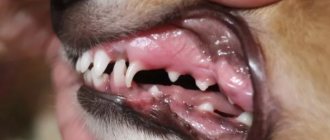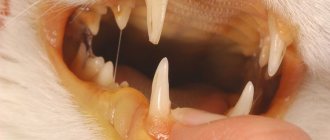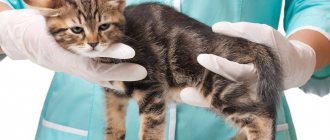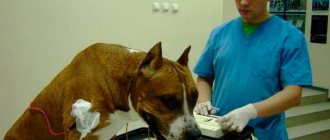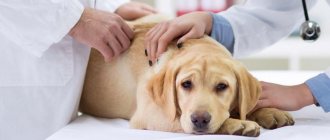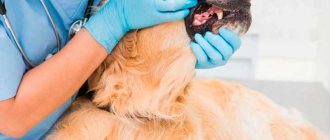What is coronavirus? What diseases does coronavirus cause in cats? Is it dangerous for humans? How to protect your cat from getting an infection?
Coronavirus infections are quite widespread among wild and domestic cat populations. These diseases cause a lot of trouble to the owners of catteries, where, due to the large number of cats being kept together, it is difficult to ensure the cleanliness of the livestock from infectious agents and there is a high risk of animals becoming infected from each other.
Types in adults
Parvovirus
As a percentage, 93% of dogs with enteritis suffer from parvovirus infection. The incubation period is from 3 to 10 days. The disease can occur in cardiac, intestinal or combined forms. The course of the disease is always acute and rapid. High mortality rate (up to 80%) among puppies and adult dogs with weakened immune systems, severe treatment of parvovirus enteritis.
The virus enters the dog's body through the mouth or nose. A healthy animal can become infected in several ways:
- Through direct contact with a dog that has recently had enteritis, or whose disease is progressing in an acute form.
- Contact with feces or vomit of an infected animal. The body of a recovered animal continues to secrete the virus through feces, saliva and urine for up to 3 weeks.
- Through infected food, water, bedding and other objects that a sick dog has come into contact with.
- The owner or other family members bring the infection on their clothes or shoes. However, parvovirus enteritis is not transmitted to humans.
Signs of the disease. How it begins if the intestines are affected:
- the dog refuses food and water;
- depressed state, complete indifference;
- repeated vomiting;
- temperature is 2-3 degrees above normal;
- frequent foul-smelling diarrhea with blood;
- rapid weight loss and severe dehydration;
- If the feces turn white, as a rule, the animal no longer has a chance.
If parvovirus affects the heart, the course of the disease is as follows:
- the dog is in an apathetic state all the time;
- does not eat, but drinks;
- rumbling in the stomach (when the stomach growls loudly);
- repeated dry cough;
- pale bluish mucous membranes;
- difficulty breathing with shortness of breath;
- cardiac arrhythmia;
- weak pulse and cold paws.
IMPORTANT : The disease is insidious in its rapidity and unpredictability. Often the time is counted on a clock. It is extremely important for the owner to immediately recognize enteritis among the symptoms and immediately contact a veterinarian for a competent treatment regimen.
Below in the article you will find symptoms, diagnosis and treatment regimen, vaccine for parvovirus enteritis in dogs!
Rotavirus
The form of enteritis is very dangerous for puppies. Another name for the disease is “intestinal/stomach flu.” The incubation period is from 2 to 7 days. In the dog's body, rotavirus is transported through the blood into the gastrointestinal tract and is localized in the epithelium of the small intestine. Swelling and destruction of the mucous membrane occurs.
Infection occurs in the standard way: through the oral-fecal route through contact with an infected dog or a dog that is a latent carrier of the virus. Among the main reasons for the development of the disease are poor care and enclosure maintenance, worms, and systematic stress of the animal.
Symptoms of rotavirus:
- sudden increase in temperature to 41 degrees;
- refusal to eat due to increased thirst;
- sudden changes in behavior: a playful, active dog suddenly becomes lethargic and apathetic, hides in dark, secluded places, whines;
- discharge from the nose and eyes;
- rapid weight loss;
- when palpating the abdominal area, the dog whines in pain;
- light yellow diarrhea with mucus.
In the acute form of rotavirus, small puppies die 2-3 days after infection . The diagnosis can be confirmed by analyzing stool, nasal swabs and eye discharge.
Coronavirus
A fairly rare form - 7% of 100 cases of enteritis. Infection occurs in the same way as with parvovirus: direct and indirect contact with a sick animal. The virus destroys the epithelium of the small intestine and colon, the mucous membrane of the nasopharynx, and the walls of blood vessels. Exhaustion and intoxication of the dog’s body occur due to the rapid growth of pathogenic bacteria in places of erosion and small ulcers on the intestinal mucosa.
Symptoms appear within 1-2 days after infection and will depend on the dose and degree of virulence of the virus, the age of the dog and the state of its immunity. The disease occurs in one of three stages: latent, acute or hyperacute. The characteristic symptoms are similar to parvovirus enteritis, but not as pronounced. The mortality rate is lower than in the first case, but puppies are still the first at risk. Pay attention to the signs of acute coronavirus enteritis:
- refusal to eat;
- vomiting and foul-smelling watery diarrhea with blood;
- severe dehydration, exhaustion;
- certain signs of heart failure.
Chances of recovery are 50/50 . A lot depends on the dog’s immune system.
In the latent form, the disease is practically asymptomatic. Clinical signs are very mild: the dog loses weight, is depressed, and refuses to eat. Diarrhea becomes chronic, heart rhythm is disturbed. Most often, the disease is transmitted in a latent form by adult dogs with weakened immune systems. The prognosis is generally favorable. With complete, timely treatment, the animal recovers within 7-10 days.
The hyperacute form refers to a combination of several acute intestinal infections: parvo-, corona-, rotavirus enteritis, which occur simultaneously. The dog suddenly becomes lethargic and refuses to eat. The temperature rises to 41 degrees, repeated vomiting and diarrhea with a pungent putrid odor appear. In most cases, the dog dies within two days.
Eosinophilic
Inflammation of the small intestine due to excessive accumulation of eosinophils on its walls. Along the way, the stomach and colon may be damaged. Among the causes of damage are side effects of medications, poor nutrition of the dog, and long-term food allergies. Signs of the disease should alert you: periodic vomiting and diarrhea, weight loss.
The diagnosis is made based on the results of urine, blood and x-ray tests. But it can be confirmed 100% after endoscopy and biopsy of the affected tissue. In most cases, the prognosis is favorable: with proper treatment and diet, the animal goes into stable remission.
Traumatic gastroenteritis
The diagnosis is made when the mucous membrane of the stomach and intestines is damaged by stones, sharp fragments of sticks, plastic or bones that the dog swallowed while eating or playing. The disease can lead to partial or complete intestinal obstruction.
Main features:
- apathetic state;
- temperature above 39.5 degrees;
- complete or partial refusal to eat, vomiting;
- rapid dehydration;
- dense, as if “tight” stomach. The dog reacts painfully to touching him;
- gurgling in the stomach.
The diagnosis is confirmed by x-rays, abdominal ultrasound and stool analysis.
Hemorrhagic
The clear and reliable causes of the disease are unknown. The following are noted as provoking factors:
- ingestion of unusual food or generally inedible foods,
- intoxication of the body,
- tumors or blockage of the gastrointestinal tract,
- severe stress,
- problems with blood clotting,
- the presence of intestinal parasites,
- intestinal or stomach ulcers.
Alarming signs - profuse diarrhea with blood, complete or partial refusal to eat, depressed state, fever.
Diagnosis requires results of blood tests, stool tests and endoscopy. In some cases, an intestinal biopsy may be required. The disease is severe and without timely emergency help the dog dies.
Chronic
This form of enteritis in dogs occurs after intestinal infections, frequent allergies, parasites, after surgical interventions, gastrointestinal resections, tumors.
Chronic enteritis is characterized by these symptoms:
- Dysbacteriosis.
- Diarrhea and constipation.
- Increased fatigue, lethargy, dehydration, decreased appetite and body weight.
- Hypovitaminosis.
- A chronically ill animal is exhausted, the coat is dull and brittle. According to blood indicators, iron deficiency anemia is increasing. The load on the heart and on most organs and systems increases.
Viral infectious enteritis
Infectious enteritis is an inflammatory disease of the small intestine caused by bacteria or viruses.
Viruses are the cause of the disease in 70% of cases. Viral enteritis is acute. Enteritis caused by a virus rarely occurs only in the small intestine. Most often, this disease occurs in the form of gastroenteritis (involving the stomach) or enterocolitis (involving the large intestine). Viral enteritis are anthroponotic infections, that is, they circulate only among people. The mechanism of transmission of infection is fecal-oral. Infection with these diseases occurs mainly through contact, water and nutrition. The airborne route of transmission of these viruses has been questioned. Coronavirus enteritis is observed in domestic animals (dogs and cats). However, the types of virus that cause disease in animals are not dangerous to humans.
Viral intestinal infections mainly affect children under 3 years of age. This is due to the imperfection of the intestinal immune defense.
The most common and well-studied form is rotavirus enteritis. Other forms, including coronavirus enteritis, have not been studied enough.
In puppies
Enteritis poses a clear mortal threat, first of all, to puppies aged 1.5 to 6 months. Infected babies born from an unvaccinated mother with a helminthic infestation have the lowest chance of survival. Immunoglobulins in the milk of a vaccinated bitch are transferred to puppies. This also does not guarantee 100% that the puppies will not get enteritis, but it still provides a certain protective barrier.
It is at 1.5 -2 months that the puppy is separated from its mother and handed over to a new owner. He stops receiving the necessary antibodies from milk, in most cases he is wormed in one way or another and experiences severe stress. Together, these factors can very quickly provoke enteritis.
Symptoms will vary depending on where the virus has entered. If it is in the intestines, the puppy suddenly loses its appetite, vomiting and foul-smelling diarrhea with blood impurities begins. If the virus infects the heart muscle, the puppy’s death occurs quickly and without clear symptoms.
WARNING : If you have parvovirus, your puppy's body temperature may remain normal. In addition, the puppy, although already infected, may still show normal activity and a good appetite. Do not overlook any case of vomiting or diarrhea, so as not to lose your dog over the next 2-3 days.
Symptoms
The disease develops several days after infection (usually 1 to 5 days). It develops acutely. Usually all symptoms occur simultaneously, but their severity may vary.
All viral intestinal infections are accompanied by three main syndromes:
- gastroenteritis or gastroenterocolitis;
- intoxication;
- dehydration.
Intestinal damage is manifested by frequent loose stools, nausea, and repeated vomiting of stomach contents. Loose stools are repeated several times a day and can persist for up to 5 days. Vomiting is most often observed only on the first day of the disease. Moderate pain in the upper abdomen and rumbling in the intestines often appear. The stool quickly becomes watery. The appearance of any impurities (blood, pus) in the stool indicates a complicated course of the disease.
Intoxication is manifested by increased body temperature, headache, weakness, and lack of appetite. High fever is unusual. More often there is an increase in body temperature to 37.5–38˚C. Elevated body temperature can persist for up to 3 days.
Dehydration is manifested by a dry tongue. Outwardly, the patient is pale, with sunken eyes. With severe loss of chlorides, muscle pain and cramps appear. Blood pressure may decrease with the development of collapse.
Rotavirus enteritis is the most common form of the disease. It occurs in 60% of children with viral intestinal infections. It occurs mainly in winter. Rotavirus enteritis is manifested primarily by increased body temperature and frequent vomiting. It is believed that by age 4, 90% of children have had this infection at least once.
Adenoviral enteritis is less common. It is more likely to be transmitted by airborne droplets. With this form, intoxication and fever are more pronounced.
Coronavirus enteritis is rare in humans. Coronavirus infection most often manifests itself in damage to the upper respiratory tract with the development of rhinitis, laryngitis, and less often bronchitis. Coronavirus enteritis occurs mainly in children in the form of short-term epidemic outbreaks.
How is it transmitted?
Is it contagious to humans?
Is this crap transmitted from dogs to humans? None of the forms of enteritis in dogs are dangerous to humans . The direct threat from an infected dog is exclusively towards a healthy dog. Infection occurs either through direct contact while walking, or when a healthy dog sniffs the feces and vomit of a sick animal.
Is it transmitted to cats?
Can a cat get infected from a dog? No, in this case the infection occurs within one species: from cat to cat, from person to person.
Can a vaccinated person get sick?
Can an adult dog get sick? Unfortunately, no one will ever give a 100% guarantee that the vaccine will protect your animal from any misfortune. But vaccination always helps to overcome the disease much faster, easier and, in the end, just to survive.
How to keep others safe
- Is it transmitted from dog to dog - yes. If you have several dogs and one of them is sick with enteritis, it is extremely necessary to isolate it and not allow it in any form to have contact with healthy animals .
- At the same time, pay attention to the absence of drafts in the room where the sick animal is located. If you have a house, take the dog into the house, do not leave it in the yard or garage. This can significantly worsen the course of the disease, and you will not be able to control its condition. The best option is to place the animal in a special collapsible cage of adequate size, away from any television and radio equipment.
- Wash your hands extremely thoroughly with disinfectant after each contact with a sick dog, before moving on to interact with healthy animals.
- It is also strongly recommended to leave outside the premises in which healthy dogs are located all clothes and shoes in which you came into contact with a sick pet.
IMPORTANT : Enteritis viruses are extremely tenacious. All household items, from bowls and combs to carpeting, that an infected dog has come into contact with should not be used in any way on healthy animals.
Disinfection: room cleaning
Parvovirus enteritis is incredibly tenacious: it can persist for six months to 1 year. However, already at a temperature of 60 degrees, the virus persists for up to 45 minutes, boiling kills it in 16 seconds, direct sunlight and ultraviolet radiation - in 4 minutes.
The virus is resistant to oxidizing agents and fat-soluble substances. One of the best disinfectants for parvovirus contamination is formalin , a 0.5% solution of which instantly kills the virus.
After recovery or (
